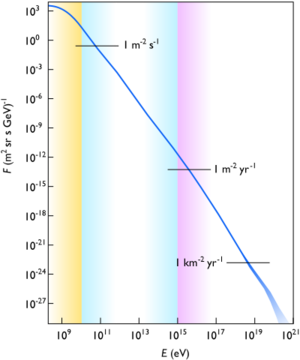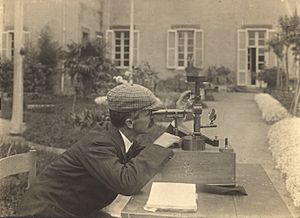Cosmic ray facts for kids

Cosmic rays are super high-energy radiation that mostly comes from outside our Solar System.
The word ray is a bit misleading. At first, scientists thought cosmic rays were mostly electromagnetic radiation, like light. But they later found out these "rays" are actually tiny particles!
Most cosmic rays are protons (which are the centers of hydrogen atoms) and alpha particles (which are the centers of helium atoms). Some are also electrons, gamma rays or photons, and a very small amount are even heavier particles.
Contents
Where Do Cosmic Rays Come From?
Scientists aren't exactly sure where all cosmic rays come from. There's good evidence that many of the main cosmic rays come from huge stars exploding, called supernovae. But this isn't thought to be the only place they start.
How Were Cosmic Rays Discovered?
In 1909, a scientist named Theodor Wulf created a special device called an electrometer. This tool could measure how much radiation was present inside a sealed box. He used it to show that there was more radiation at the top of the Eiffel Tower than at its base. However, his findings weren't widely accepted at the time.
Then, in 1911, Domenico Pacini noticed something interesting. He saw that the amount of radiation changed at the same time over a lake, over the sea, and even a few meters deep underwater. Because the radiation decreased underwater, Pacini figured that some of the radiation must be coming from somewhere other than Earth's natural radioactivity.
The big breakthrough came in 1912 with Victor Hess. He took three improved electrometers up to an amazing height of 5,300 meters (about 3.3 miles) in a free balloon. He discovered that the amount of radiation was about four times higher up there than on the ground!
Hess even did a flight during a near-total eclipse of the Sun. Even with the Moon blocking most of the Sun's light, he still measured more radiation at higher altitudes. This helped him realize that the radiation wasn't coming from the Sun. He concluded that "radiation of very high penetrating power enters from above into our atmosphere." For his amazing discovery, Hess later received the Nobel Prize in Physics in 1936.
A couple of years later, in 1913–1914, Werner Kolhörster confirmed Hess's findings by measuring the increased radiation at an even higher altitude of 9 kilometers (about 5.6 miles).
What Happens When Cosmic Rays Hit Earth?
Cosmic rays can have incredible amounts of energy, much more than what our most powerful particle accelerators can create.
When these super-energetic cosmic ray particles enter the Earth's atmosphere, they crash into other particles, like molecules of oxygen and nitrogen. This collision creates a huge burst of lighter particles, which scientists call an 'air shower'.
The number of particles made in one of these air showers can reach billions! All these new particles stay very close to the path of the first cosmic ray. An air shower can contain x-rays, muons, protons, alpha particles, pions, electrons, and neutrons.
Some of these particles, like muons, can even reach the surface of the Earth and go a little way into shallow mines. Scientists can easily detect these muons with special particle detectors. When many detectors pick up particles at the same time, it shows that all those particles came from one big air shower event.
Why Are Cosmic Rays Important?
Cosmic rays have a few important effects on Earth and in space.
How Cosmic Rays Affect Earth's Chemistry
Cosmic rays are always creating certain unstable isotopes in Earth's atmosphere. One important example is carbon-14. This happens when a neutron from a cosmic ray hits a nitrogen atom:
- n + 14N → p + 14C
Cosmic rays kept the amount of carbon-14 in the atmosphere pretty steady for at least the last 100,000 years. This was true until nuclear weapons testing started in the 1950s. This steady level of carbon-14 is super important for radiocarbon dating, a method used in archaeology to figure out the age of ancient objects.
How Cosmic Rays Affect Space Travel
Cosmic rays are also very important because they can harm microelectronics and living things (like astronauts!) outside the protection of Earth's atmosphere and magnetic field. This is a big challenge for long space missions, like traveling to Mars.
Images for kids
-
The VERITAS array of air Cherenkov telescopes, which detect very high-energy gamma rays.
-
A comparison of radiation doses, including the amount detected on the trip from Earth to Mars by the RAD on the MSL (2011–2013).
See also
 In Spanish: Radiación cósmica para niños
In Spanish: Radiación cósmica para niños






